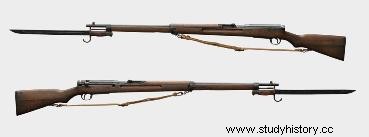
The Arisaka rifle design remained standard in the Imperial Japanese Army from the turn of the century until after World War II. The Arisaka was accurate, but the addition of a metal dust cover above the bolt made its reloading noisy and its chamber prone to clogging. The Arisaka was built for an exceptionally long time, particularly due to the average stature of the Japanese troops and the tight jungle terrain they fought in during the war, which the Arisaka suited well. The Meiji 1938 (or Type 38), was replaced in 1940 in favor of the Arisaka Type 99 rifle, which fired a new 7.7 mm cartridge.
In 1897, Colonel Niriaki Arizaka, director of the Tokyo arsenal, created a bolt-action infantry rifle combining elements of the Mauser 1893 and Mannlicher 1890, which was adopted the same year by the Japanese army as the Type 30 rifle ( 30th year of the Meiji era) for his infantry. The cocking lever is straight, the butt is of the pistol type. The barrel is in two parts and the handguard covers half of the barrel.
The store is mauser k98 type. Its ammunition is the 6.5 mm Type 30. Produced by the arsenals of Tokyo and Kokura, it gives birth to a Type 30 carbine arming the cavalry and a Type 35 rifle intended for the Imperial Navy. The carbine is shorter and lighter, with the Type 35 rifle having a different bolt action. The Russo-Japanese War demonstrates the weaknesses of the early Arizaka.
The Arisaka Type 38 Infantry Rifle
It is a Type 30 whose cylinder head has been greatly modified thanks to borrowings from the Spanish Mauser 1893. It was adopted in 1905 and produced by Japanese (Tokyo, Kokura, Nagoya), Korean (Jinsen) and Manchurian (Mukden) arsenals from 1907 until 1939. It armed Japanese infantrymen. It was exported to Great Britain around 1915 (then sent back to Russia), Brazil and Mexico (in 7 mm Mauser caliber). Weapons taken from the Japanese armed Russia, China, France, Korea, Indonesia, Burma, Thailand and Vietnam, following the Japanese expansionist conflicts. It is derived from it a short rifle and a carbine. All Arizaka Type 38 rifles and carbines are constructed from machined steel and wood. Their ammunition is the 6.5 mm Type 38, fired in a barrel with six rifling on the right. Their front sight has a base protected by two lugs and the rise with a board is graduated up to 2,400 m. There is a fixed rear sight calibrated for 400 m. The removable bottom magazine holds 5 cartridges in nested stacks.
This weapon is reputed to be one of the strongest bolt-action weapons ever built. "Tests" carried out by the Americans reveal its extreme solidity:a modification of the chamber - without modifying the barrel - allowed them to fire the standard US cartridge, the powerful .30-06 Springfield. Although the difference in caliber is 1.0 mm, the firing of a hundred rounds in such weapons did not cause the barrel to explode, although subjected to severe test. [ref. needed]
Arisaka are very rare in Europe.
The Type 38 short shotgun
This first shortened version is distributed to engineers, gunners and telegraphers. He receives a bayonet.
The Type 38 rifle
This weapon is distributed to the cavalry. The rise is graduated up to 1,500 m. The shoulder strap is fixed laterally. There is a folding butt variant for paratroopers.
Other variants
The Type 38 rifles gave rise to the Arisaka Type 44 carbine (1911) and the Type 97 sniper rifle, before being theoretically replaced by the Arisaka Type 99 rifles.
Type 38
Country Japan
Type Rifle
Ammunition 6.5 x 50 mm SR
Period of use 1905 - 1940
Weights and dimensions
Mass (unloaded) 4.07 kg
Length(s) 1275 mm
Barrel length 798mm
Technical characteristics
Mode of action Manual
Maximum range 350 m
Rate of fire 15 rounds per minute
Initial velocity 731 m/s
Capacity 5 cartridges
Viewfinder adjustable bezel
Variantes grenade launcher, bayonet, adjustable scope...
